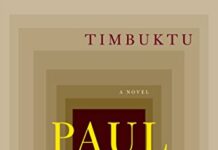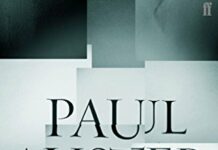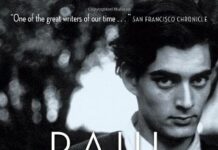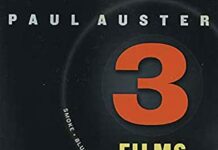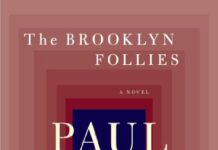
Ebook Info
- Published: 1990
- Number of pages: 390 pages
- Format: PDF
- File Size: 1.32 MB
- Authors: Paul Auster
Description
The remarkable, acclaimed series of interconnected detective novels – from the author of 4 3 2 1: A NovelThe New York Review of Books has called Paul Auster’s work “one of the most distinctive niches in contemporary literature.” Moving at the breathless pace of a thriller, this uniquely stylized triology of detective novels begins with City of Glass, in which Quinn, a mystery writer, receives an ominous phone call in the middle of the night. He’s drawn into the streets of New York, onto an elusive case that’s more puzzling and more deeply-layered than anything he might have written himself. In Ghosts, Blue, a mentee of Brown, is hired by White to spy on Black from a window on Orange Street. Once Blue starts stalking Black, he finds his subject on a similar mission, as well. In The Locked Room, Fanshawe has disappeared, leaving behind his wife and baby and nothing but a cache of novels, plays, and poems.This Penguin Classics Deluxe Edition includes an introduction from author and professor Luc Sante, as well as a pulp novel-inspired cover from Art Spiegelman, Pulitzer Prize-winning graphic artist of Maus and In the Shadow of No Towers.For more than seventy years, Penguin has been the leading publisher of classic literature in the English-speaking world. With more than 1,700 titles, Penguin Classics represents a global bookshelf of the best works throughout history and across genres and disciplines. Readers trust the series to provide authoritative texts enhanced by introductions and notes by distinguished scholars and contemporary authors, as well as up-to-date translations by award-winning translators.
User’s Reviews
Reviews from Amazon users which were colected at the time this book was published on the website:
⭐Paul Auster’s New York Trilogy has been waiting for a review for a few weeks now. I can confidently say that I’ve never read a more confusing, unresolved book than this one. What’s incredible about Auster’s work, though, is that this doesn’t condemn the book in any way. If you’re a fan of neat and easy storybook endings that are predictable from a million miles away, stay away from The New York Trilogy. If you like great writing that gives you a headache, this is the novel for you.The New York Trilogy is, like the title implies, a collection of three shorter stories originally published as three different books. While they seem to have nothing in common, the trilogy as a whole is definitely one story, or at least three facets of one story. There isn’t a sentence that could capture any of these stories, so let the back cover text intrigue you:City of Glass: As a result of a strange phone call in the middle of the night, Quinn, a writer of detective stories, becomes enmeshed in a case more puzzling than any he might have written.Ghosts: Blue, a student of Brown, has been hired by White to spy on Black. From a window of a rented room on Orange Street, Blue keeps watch on his subject, who is across the street, staring out of his window.The Locked Room: Fanshawe has disappeared, leaving only his wife and a baby and a cache of extraordinary novels, plays, and poems. What happened to him — and why is the narrator, Fanshawe’s boyhood friend, lured obsessively into his life.None of these stories follow any traditional pattern. City of Glass fizzles into existential questioning at the expense of any action. Ghosts comes to a surprising head, and is marked by the total non-characterization of its colorful characters. The Locked Room appears to be a regular mystery story, until the narrator inherits Fanshawe’s wife and life, and is wracked by dread when Fanshawe seems to have reappeared. None of these stories are an easy read, or go in the direction that you expect. Also, they make absolutely no sense.All of the stories feature intriguing overlaps. Characters have the same or similar names, patterns of events repeat, and the red notebook is frequently seen. Obsession and identity are key themes across the trilogy. In the end, all three stories hang together in such a way that they’re inextricably unrelated. There are no spoilers to give away because you will finish the book without a clue of what happened.Many people dislike Auster and his work for this reason, but I found something intriguing under the surface of The New York Trilogy. Auster is writing in unfamiliar territory, and he doesn’t have all the answers himself. The book could even be seen as partially autobiographical. Paul Auster is actually a character in multiple stories, and the book expertly blurs the line between reality and fiction. It makes for an intensely entertaining and thought-provoking read.If you read The New York Trilogy, you will find yourself obsessed the entire time you are reading it. Just like the characters in the stories, you will throw books, pace and debate what is true, and find yourself increasingly obsessed with understanding what is going on. Auster has accomplished one thing for sure: whatever this book is about, it’s exciting enough to totally enmesh its readers in its world. I’m looking forward to putting more time into decoding the meaning of the story — I have lots of notes, but no answers yet!
⭐Paul Auster’s novel, The New York Trilogy, is a unique blend of metafiction and mystery, with a definitive detective, noir flavor and vibe. There is a common bond within all three tales in that there is a sense of isolation experienced within the main character’s point of view as they head towards an unseen destination in their investigation/search. At points, the protagonist, in looking for someone or something, is forced to look inwardly, sometimes painfully and truthfully, at themselves.In “City of Glass”, author Quinn assumes the role of “detective” as he tries to locate and find the whereabouts of the elder Peter Stillman. Stillman allegedly wreaked severe psychological damage on his son, Peter Stillman. The case and search take on a life of its own as Quinn becomes immersed in this case to the point of breakdown and obsession. Auster captures the frustration of Quinn during his search: “…there seemed to be no substance to the case. Stillman was a crazy old man who had forgotten his son. He could be followed to the end of time, and still nothing would happen.”“Ghosts”, the second of the trilogy and my favorite of the three, is quite a colorful read (in more ways than one). A man named Blue is hired by a guy named White to tail another man named Black (make sense). In much the same manner as “City of Glass”, there is the sense that the one doing the tracking must get into the head of the one they are tracking. They must come up with their own theories, and Blue does not know enough about Black so must take this on in a forceful way, delve into the makeup of Black: “They only way for Blue to have a sense of what is happening is to be inside Blacks’ mind to see what his is thinking, and that of course is impossible.” After much speculating and wondering, things shift quite suddenly in the second part of the plot and we have interaction between Blue and Black that takes us to a sudden conclusion.“It seems to me now that Fanshawe was always there. He is the place where everything begins for me, and without him I would hardly know who I am.” So begins the final installment in the trilogy, “The Locked Room.” The Locked Room focuses on the search for a writer named Fanshawe, who has been missing for six months. Fanshawe’s wife contacts an acquaintance from Fanshawe’s childhood to help look for the writer. Eventually, things get more complicated when she asks, as a favor, for him to critique her husband’s writings. Becoming fully immersed in the case, the narrator suddenly seems to assume the role of Fanshawe, marrying his wife and trying to get his works published. The narrator takes on much of who Fanshawe is. As the narrator gets closer to understanding more, he begins to question a sense of his own identity.I found The New York Trilogy to be a breath of fresh air, very non-traditional and unique.There is ambiguity and vagueness to all three novellas, and that is perfectly fine. It forces the readers to be much like the main characters, and assume their own conclusions. And much like the main character in each of the plots, I pushed myself to read on, looking for clues and meanings within. Auster allows room for the reader to interpret, discuss, and think about, much of what goes on.
⭐But not my new favorite author. Not even close. The best I can say is reading the stories wasn’t total drudgery and had moments of mild amusement. Yeah, I can’t, in good faith, recommend it. I wish I could. (The physical package is outstanding, you know, the cover.)
⭐The New York Trilogy’ is what I call a ‘literary’ book – it’s a lot about the style and the cleverness, and not necessarily about the story. If I was going to be cruel, I’d say it’s written more for the pleasure of the writer than the reader. I’m an intelligent person but I read for pleasure – I don’t like books that are hard work or that don’t give me some sort of enjoyment pay off. I’m sure I could have understood and read lots of deep and meaningful things into this complex novel, but I didn’t want to and couldn’t be bothered.In order to write a helpful review, I’ll try to be objective by noting that’s my personal preference and I know others like to read books that are intellectually challenging and that can be discussed at book groups etc. To that end, the writing is good quality i.e. page by page it’s quite readable – apart from a few bits that stray into ‘stream of consciousness’ territory which I always hate. The story consists of three novellas, all set in New York, as you might expect, and all with a theme of private detectives or missing people. I enjoyed the third section the most.I have the nagging feeling that I really missed some deeper meaning that the book was trying to convey, and that leaves me with a sense of failure and frustration – not a good way to be left feeling after something you were doing for enjoyment. If you enjoy complex, literary books and working out the meanings hidden in text, you’ll probably have a field day. If you don’t, I find it hard to see what you’d enjoy about this novel.
⭐I was looking forward to this book as I had recently read the excellent Brooklyn Follies. But I was very disappointed with this novel. A pretentious load of drivel that took a lot of effort to finish and honestly was a waste of time.
⭐The single best thing about this work is the thick, ominous atmosphere Auster manages to build. Once you learn that the plot kind of moves in self-referential circles, you just want to put it behind you.
⭐What could have been entertaining but not remarkable turned out to be a waste of time for myself reading it and Paul Auster writing it. The writing was good for the most part but Auster seemed to be more focused on trying to be different and unique that everything else in the book failed. I would not recommend you read it unless you have to for a university course or something like that. On the plus side it does have plenty of good ideas but all of them are lost in Auster’s desire to be as meta-textual as possible.
⭐Not a “light reading” book, nor is it really a trilogy. It was not what the three titles had led me to expect. It is a mystery but not the typical mystery/ghost story I was expecting. The best adjective for me would be “weird”, but it is nevertheless fascinating. It is essential to see all three books as a single entity and best read as close together as possible to get a better understanding of it. You will either put it straight in the trash can or need to re-read several times. Not quite like anything I have read before, its own genre.
Keywords
Free Download The New York Trilogy in PDF format
The New York Trilogy PDF Free Download
Download The New York Trilogy 1990 PDF Free
The New York Trilogy 1990 PDF Free Download
Download The New York Trilogy PDF
Free Download Ebook The New York Trilogy
